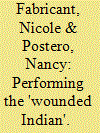| Srl | Item |
| 1 |
ID:
133592


|
|
|
|
|
| Publication |
2014.
|
| Summary/Abstract |
This article examines Right-wing political performances in the Bolivian Eastern lowlands where regional elites claim to be living under the authoritarian dictatorship of Left-leaning President Evo Morales. We analyse how regional elites advocate for political autonomy through embodied and spectacular performances linked to discourses of indigeneity, human rights and democracy. Right-wing leaders try to legitimise their claims for justice and territorial control by strategically aligning themselves with lowland 'Indians' - who are equally wounded by Morales's plan to run a massive highway though their communities and territories. Through theatrical exhibits in the plaza and a spectacular assembly spotlighting an indigenous representative as an emblematic hero of TIPNIS, regional elites perform a shared history of marginalisation, while simultaneously presenting themselves as 'saviors'. We argue, however, that there is a dark side to these performances, as they elide long histories of racialised labour and economic injustice in the region.
|
|
|
|
|
|
|
|
|
|
|
|
|
|
|
|
| 2 |
ID:
174157


|
|
|
|
|
| Summary/Abstract |
This article explores the roots and the consequences of the 1979 Iranian Revolution with a focus on one of Iran’s constituent peoples, the Kurds. It provides historical perspectives on a specific people in relation to the Revolution and aims to enhance historical awareness on the Revolution and contribute to debates around it. It is divided into two main parts. The first part deals with the roots of the Revolution by presenting an overview of social change and transformation during the preceding decades to create a historical foundation, which studies on the Kurds in Iran have usually lacked. The second part deals with the consequences of the Revolution, analysing the autonomy movement, the characteristics of which are closely linked to social change of the preceding decades. Despite the availability of sources on the period, previous scholarship has been devoid of sufficient historical analysis on both the background to, and events which took place during, the Revolution. This article addresses that gap by presenting an analysis of that historical process.
|
|
|
|
|
|
|
|
|
|
|
|
|
|
|
|